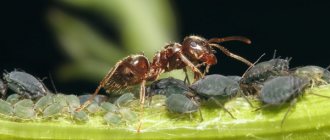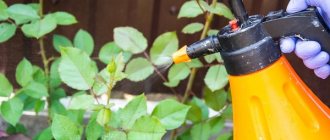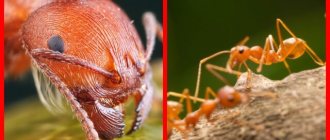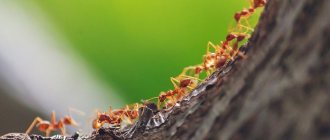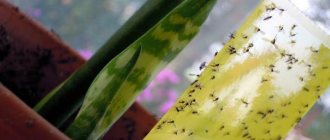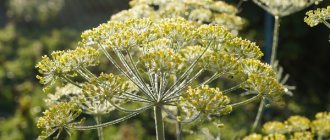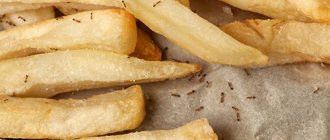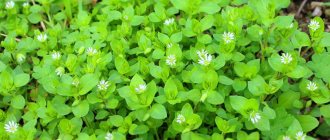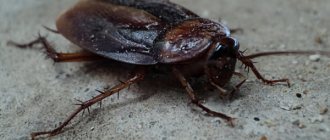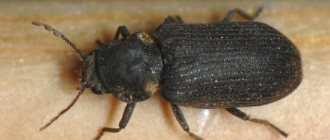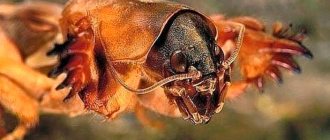- Biological characteristics of aphids
- Life cycle of aphids: or why does it reproduce so quickly?
- Main types of aphids and risk groups for plants
- Symptoms of damage
- Prevention and control measures for aphids Chemical preparations
- Contact drugs
- Intestinal drugs
- Systemic drugs
- Biological drugs
Damage from aphids
Leaf aphids of any species, green or black, feed on plant tissues, mainly young shoots, and eat leaf and flower buds.
The harm it causes is colossal, first of all, because leaf aphids reproduce very quickly, forming huge colonies in a matter of days and producing about 50 colonies per season.
In addition to the general weakening of the plant: deformation of leaves and entire branches, loss of peduncles, buds, ovaries and fruits, aphids secrete sticky secretions that clog the stomata of the leaves, or a fungus settles on them. When biting leaves, aphids can spread viral diseases.
Aphids can completely destroy young plants that have one or two growing points.
The damage from aphids is aggravated by the fact that they are not at all selective in plants; they devour everything: garden flowers, seedlings and mature vegetables, fruit trees, shrubs and herbs.
She has special preferences, for example, plums, cherries, roses; currants are one of the first to be affected by aphids. Here, different species of aphids have their own taste preferences; black aphids prefer fruits - currants, apple trees, plums, green aphids - roses, chrysanthemums and other flowers. However, this is not a general rule; sometimes it seems that aphids eat everything!
Manifestation
Aphids in a greenhouse are almost invisible to the eye. First, aphids settle on the lower part of the leaves, and only then on the buds and young shoots. It sucks the vital juices out of them, as a result of which the leaves curl, the shoots grow poorly, the flower stalks become bent, and the buds dry out without ever blooming. In bulbous perennials, in addition to the ground part, the bulb itself is also damaged.
At the same time, the pests secrete sugary excrement, “honeydew,” which freely spreads throughout the plant, attracting ants, wasps, flies and bees. Sedentary aphids are in symbiosis with ants, supplying them with food, and the ants protect it and move it to a new place (this applies to wingless individuals).
Where do aphids come from on plants?
A fertilized female aphid lays eggs on branches and bark of trees, in the root zone, usually in secluded and hard-to-reach places. The eggs overwinter quietly in clutches, or they are kept until spring by ants, and then dispersed among any of the most attractive plants.
In the warmth, the eggs rapidly develop into adult wingless females, capable of reproducing without fertilization - they produce the main hordes of enemies of our crop.
By the end of June, and in warm weather by the end of May, a new form of adult insects appears in the aphid colony - flying females. They are the reason for the widespread spread of pests. They are called disperser aphids, their task is clear and understandable - to cover as large an area as possible and lay the next generations of eggs. If we take into account the help of the wind, then the spread of pests is several tens of kilometers from the place of departure. After mating, females lay overwintering eggs and a new cycle begins in the spring.
You may have noticed a phenomenon where aphids either disappear on their own or are found again on plants - these are dioecious aphids; in the first half of the season they actively reproduce on some plants, and with the appearance of winged females they move to another group of plants, at the end of summer - early autumn, they return to the first bushes.
Ants also contribute to the spread of aphids - they feed on the sweet syrup that aphids secrete (honeydew). Ants, like proper farmers, grow aphids, take care of their eggs, protect them from other insects and are constantly near the food source, trying to increase the plantations.
What is a pest?
Aphids belong to a group of insects that has approximately 4,000 species. All of them are distinguished by their miniature size (0.5-2 mm) and the characteristic structure of the oral apparatus, which has the shape of a proboscis. Adult insects have long legs. Their body is slightly elongated, oval in shape. The color can be different: black, green, brown, beige or red. In some cases, it has the same color as the plant on which the aphid has settled.
The insect's body is soft, transparent, and sometimes has a waxy coating. Aphids do not live alone, but in large colonies. There are wingless and winged species of these pests.
Females very often do not have wings, so they constantly live on one plant, performing the main function - reproduction. Winged individuals spread very quickly, so it is difficult to fight them.
Most female aphids are endowed with a special type of reproduction, which consists of the development of an embryo without fertilization. Larvae hatch from eggs or appear by viviparity. Females are extremely fertile - within just two weeks, each of them gives birth to up to 150 larvae.
Prevention of aphids
Need I repeat the platitude that preventing an aphid infestation is easier than fighting it? However, any gardener will say that he has noticed how aphids progress on some plants, while on others they are rather sluggish and few in number.
The point is in the condition of the plants themselves, if they are healthy, the trees and shrubs are whitened, there are no aphids on them or there are very few of them.
Starting in the fall, remove leaf litter from the garden area and mow down the weeds in the tree trunks. During this time, cut out the tops and root shoots on which the eggs can overwinter.
Contain or destroy anthills during the spring and summer. Complete destruction of anthills, as a rule, is not justified, since in cold, windy or rainy summers, ants remain almost the only pollinators of plants (for bees and bumblebees, non-flying weather sets in).
To protect trees from ants, you need to destroy anthills located in close proximity to fruit bushes and trees. Then, to prevent the ants from making a new path, a strip of dry wood ash should be poured around the trunks - it will protect the approaches to the trees, like a Chinese border. If rain washes away the ash, you need to renew the topping.
Whitewash against aphids
It is necessary to bleach the trunks of fruit crops not in the spring, as is customary for most gardeners, but in the fall, preventing the laying of pest eggs and destroying spores of pathogenic fungi.
First you need to clean the trunks of lichens, mosses and loose bark with a brush - for old trees, a metal brush, for younger trees - with stiff bristles. Wash all damage to the bark and cracks with iron sulfate and cover with garden varnish.
For whitewashing with 20% lime mortar you need to take:
- 2 kg of slaked lime and dilute in 10 liters of water or
- Dilute 1-1.5 kg of quicklime in 10 liters of water
In addition, there is another recipe for whitewashing: dilute 2.5 kg of lime, 1 kg of clay and 0.3 kg of copper sulfate in 10 liters of water.
In garden centers you can purchase ready-made whitewash based on lime and adhesives.
When whitewashing tree trunks, in addition to direct toxic contact, you seal the already laid eggs of aphids or their possible hiding places. But in the spring, whitewashing needs to be repeated.
You may argue that aphids are flying insects and can settle on trees even with whitened trunks. However, the most dangerous time for plants is the opening of young leaves, flowers, and the formation of buds, and this is early spring. By the time the aphids develop females capable of flight, the trees protected by whitewashing have time to flourish, the leaves open and harden, becoming too tough for the aphids.
Detection
Take a close look at your plants, every single one of them. If numerous colonies of point pests and sticky liquid (honeydew) are visible on the back of the leaves, buds, or shoots, and the old skin of the insects remains in white pieces, then this is a real aphid infestation.
But don't despair! When pests appear in the greenhouse, immediately start a war with them - use folk remedies, such as mechanical, environmental (biological) and chemical.
Improvement of berry bushes
To prevent berry bushes from being affected by aphids, proper agricultural practices must be carried out:
- Do not overfeed them with nitrogen - nitrogen-rich fertilizer makes plant sap sweeter and more attractive to aphids. It is especially dangerous to apply nitrogen fertilizers in the second half of summer.
- Add more ash - the need for potassium in fruit crops is very high. Potassium strengthens plant cell walls and increases the overall resistance of plants to stressful situations, such as cold. Aphids are only able to bite through the thin, delicate epidermis; they cannot gnaw through leaves with thick skin.
- Do not overfeed the trees, but use fertilizers containing not only nitrogen, potassium and phosphorus, but also microelements (boron, zinc, molybdenum, iron).
- Strictly monitor the acidity of the soil - plants absorb nutrients only at the optimal soil pH for them.
- Replenish consumed calcium in a timely manner. Apply lime on soils rich in humus or peat bogs (1-2 kg of fluff per 3-4 year old currant bush for digging), and on sandy and sandy loam soils - dolomite flour. Let us recall the approximate application rates of dolomite flour (less on light soils, more on heavy soils):
- acidic soils (pH < 4.5) 500–600 g/sq.m. m
- medium acidic (pH 4.5–5.5) 450-500 g/sq. m
- slightly acidic (pH 5.5–5.8) 350-450 g/sq. m
Preventive measures
To avoid infestation of plants with aphids, you need to thoroughly inspect the planting material and seedlings before planting. To attract the attention of hoverflies, which destroy aphids, it is advisable to plant parsley, dill or carrots next to the beds. A good method to prevent aphids is to mulch paths with wood shavings. An earwig lives in it, for which aphids are one of the food sources.
To avoid aphid infestation, you need to ensure that ants do not appear in the garden. If they are identified, you must immediately take all necessary measures to get rid of them as quickly as possible. To repel aphids, you can plant thyme or lavender in flower beds, the smell of which aphids cannot tolerate.
Feeding plants should be done very carefully. You should not overfeed them with fertilizers, but you should also not allow the soil to become depleted - aphids prefer weak and overfed plants. Infestation by aphids can also be prevented by timely weeding, loosening the soil, and mulching it.
Where can I find this data? I can save you from it in the garden, no. How to freeze it - will it help?
I'm afraid you won't be able to cope with the aphids in the frost, since at sub-zero temperatures the aphids do not die, but simply hibernate. It overwinters as larvae and wingless females on the roots and trunks of trees. At +5 degrees, the aphids wake up and begin to harm again.
#1 mastersveta
- Administrators
- 652 messages
- Tyumen city
An exceptional attack of insect parasites, for example, aphids, on one of a group of seedlings, can serve as an indicator of the best taste qualities of the future fruits of this seedling.
Aphids are a large group of sucking insects with incomplete metamorphosis. Aphids that cause harm in greenhouses are incomplete cycles, i.e. There are no sexual stages in their development cycle. Aphids reproduce by viviparity, i.e. winged and wingless virgins lay larvae on plants, which soon begin to feed, grow, and molt, resulting in the formation of winged or wingless virgin females. In open ground, most species of aphids that damage tomatoes reproduce in the same way and overwinter on weeds. However, some species, such as the green peach aphid, are capable of forming a sexual generation and overwinter on peach in the egg stage (a full-cycle species).
First, try to determine the type of aphid that has settled on your plants; this will later help you choose the best methods for controlling aphids.
Common potato aphid (Aulacorthum solani).
Description. This type of aphid is a dangerous pest of tomatoes and other vegetable crops. It is found everywhere in Russia. In greenhouses in the off-season it is preserved on weeds. The common potato aphid is represented by a number of forms that differ not only morphologically, but also in food specialization.
Adult wingless individuals of the common potato aphid are quite large (up to 3 mm), shiny, green in color. This aphid is similar in appearance to the green peach (greenhouse) aphid (Myzodes persicae), but differs from it in the longer antennae in wingless females and the absence of a single dark spot on the dorsal side of the abdomen in winged females. The body of the winged female aphid is elongated-oval, tapering towards the end, 2.3-3 mm long and 1.2-1.4 mm wide. The body color of the aphid is green, yellow-green, whitish, brownish or reddish, without dark spots.
Winged female common potato aphid with transverse sclerotized stripes on the dorsal side of the abdomen; the stripes do not merge into a single spot.
In greenhouses, aphids develop in an incomplete cycle. Usually overwinters in greenhouses and in technological corridors on weeds (often on woodlice and bindweed). Aphids switch to feeding on cultivated plants even during the growing of seedlings. In hot summers it is less common in greenhouses. By autumn, the number of common potato aphids on tomatoes increases. Given favorable conditions, aphids are able to reproduce year-round.
The common potato aphid spreads mainly due to the flight of winged females. All age stages of aphids usually overwinter on thistle, woodlice and bindweed.
Fighting aphids
Watering with boiling water
You can water currants and gooseberries with boiling water when there is still snow on the site, and in the trunk circles of the fruit bush the snow has thawed (about 70 cm in diameter). Those. the snow on the branches has already melted, but the buds are still dormant and have not swelled!
Heat the water to a boil, pour it into a watering can with a sprinkler attachment. Then immediately water the bushes along the branches and the soil around the bushes. It takes about one watering can for a small bush. When pouring boiling water into a cold metal watering can, the water temperature drops to about 80 degrees; when watering the branches, its temperature drops to 70 degrees.
This technique allows you to destroy not only aphid eggs preserved on the shoots, but powdery mildew spores and mite clutches.
You can add 3 drops of iodine per 10 liters of water to the water for other diseases. It is important not to keep the watering can strictly in one place when watering, i.e. you need to scald, and not rinse the branches in boiling water!
Ash dusting
In the spring, before the leaves fully bloom (you can at the stage of bud opening), wet the branches with water and dust the moisture with sifted wood ash.
Soap and ash solution for aphids
Pour 300 g of ash (2 cups) into a bucket with 10 liters of boiling water, add 50 g of laundry soap shavings and leave to steep overnight. Pour the solution into the sprayer through triple gauze so as not to clog the sprayer with grains of ash. Treat all branches during bud break, at the stage of young leaves (salad greens).
Treatment against aphids with soap and Domestos
For 10 liters of water, take 100 g of tar or black laundry soap, add 5 drops (with a pipette) of Domestos (or any preparation containing chlorinol). You can spray on bare branches even at the moment when the leaves have already blossomed. 10-15 minutes after treatment, wash off the leaves with clean water from a hose. The procedure can be repeated after a couple of days.
Ammonia
Another proven way to combat aphids is ammonia. Two tablespoons per bucket of water, add 1 tbsp. a spoonful of liquid soap. Helps almost instantly. No need to rinse off.
Dog shampoo against aphids
Flea shampoo for dogs and cats contains active ingredients of the pyrethroid class, they are toxic to aphids, i.e. the composition of the solution will be the same as, for example, a solution of the insecticide Iskra. The only difference is that the shampoo contains surfactants, i.e. adhesives. It is quite difficult to calculate the dose of shampoo (the concentrations of the active substance are different).
The safe dosage for plants is approximately 1 tbsp. spoon per bucket of water (10 l). Higher concentrations may cause leaf burn!
Preparations for aphids
There are many drugs against aphids, the question is how effective they are. You need to understand that systemic drugs (solutions or tablets stuck into the ground) act from the inside - when plants are absorbed by the roots.
Enteric-contact drugs will help only if the leaves and branches are thoroughly moistened. When aphids collect a colony, the leaves become shriveled, curled up, and the solution does not reach them. In this case, before spraying with aphids, you need to cut off the tops of shoots with deformed leaves. This is possible on currant or gooseberry bushes.
On large trees and tall bushes, it is technically impossible to pick out aphids manually or cut off nests, so the success of the enterprise depends on how well you carry out the spraying.
Aphid spraying time:
- along the branches until the leaves open
- before flowering in the beginning of budding phase
- after flowering during ovary growth
- 30 days before harvesting fruits and berries
In general, there are three classes of insecticides that work against aphids: pyrethroids, organophosphates, and neonicotinoids.
It is best to use systemic neonicotinoid drugs:
- Aktara (thiamethoxam) or Confidor (imidacloprid) - they can be watered and sprayed. They help with a bang. The problem with these drugs is that they are incredibly expensive for the average gardener: for example, for the summer of 2016, a 4 g bag of actara costs about 100 rubles - this is for 5 liters of water. If there are a lot of aphids in the garden and few trees and shrubs, treatment is very expensive. Watering is advisable only on vegetables (cucumbers and tomatoes); on trees “from the inside” (with watering) the efficiency is low.
- Tanrek is also a neonicotinoid, the active ingredient is the same as that of confidor - imidacloprid, but the cost is lower, more affordable and very effective against aphids. Tanrek's consumption is 3 ml per 10 liters of water - 5 liters per tree.
- Spark Gold is also the active ingredient imidacloprid, for spraying 5 ml/10 l of water.
- Other analogues of Tanrek and Confidor: Biotlin Bau and Biotlin, Zubr, Imidor, Kalash, Commander, Confidelin, Korado, Monsoon, Prestige, Respect, Taboo, Tsvetolyuks Bau. The principle of operation is the same, the prices are different, choose any one.
Organophosphorus compounds Actellik (pirimiphos-methyl) and Karbofos, as well as their analogs - Antiklesch, Alatar, Fufanon, etc. also help against aphids, but recently there has been increasing resistance to these drugs, so they are less preferable.
Among permethrins, Kinmiks, Decis Profi, and Inta-Vir are available and effective to us.
Bio-preparations for aphids
The preparations Fitoverm and Akarin are very popular in gardening. The advantages of their use are obvious - the active substance does not penetrate through the cell membranes into the fruits and leaves, i.e. does not accumulate in plants. The preparations are non-toxic to bees already 4 hours after the sprayed leaves dry.
But there are big problems with this group of drugs - you can spray only in cool weather: optimally at 18-20°C - otherwise the product does not work; With constant use, resistant strains appear.
In addition, despite the declared safety (hazard class 3), it is known that avermectins, which include Fitoverm and Akarin, are still quite toxic, especially dangerous for children and adolescents (Popov S.Ya. Fundamentals of chemical plant protection, 2003).
Read about all effective anti-aphid drugs: How to spray berries
